2020-2021学年人教版(2019)必修一:Welcome Unit Grammar(25张)
文档属性
| 名称 | 2020-2021学年人教版(2019)必修一:Welcome Unit Grammar(25张) | 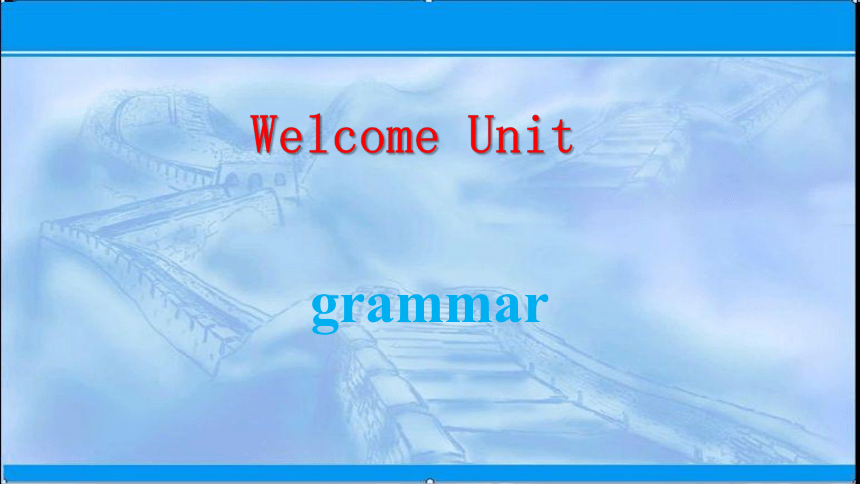 | |
| 格式 | ppt | ||
| 文件大小 | 5.2MB | ||
| 资源类型 | 教案 | ||
| 版本资源 | 人教版(2019) | ||
| 科目 | 英语 | ||
| 更新时间 | 2021-09-02 17:55:44 | ||
图片预览

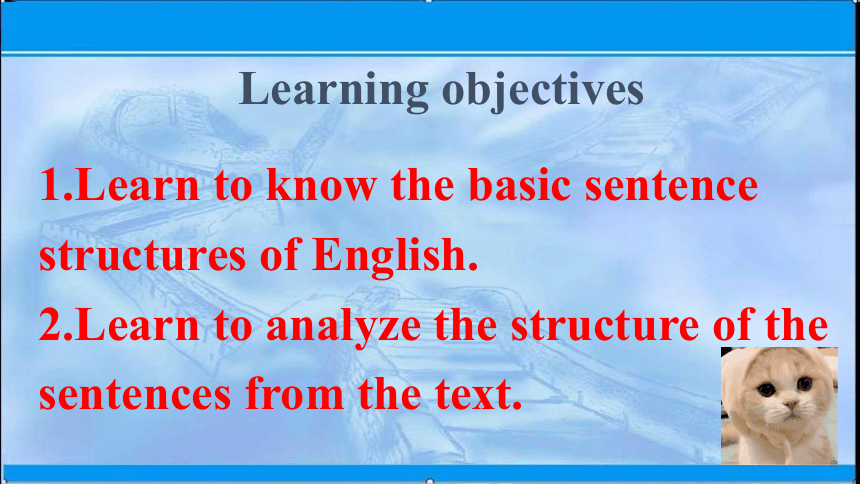
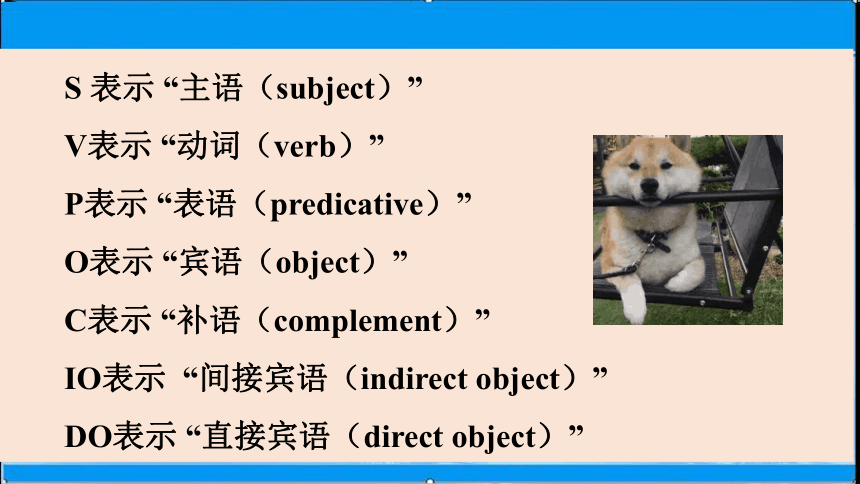
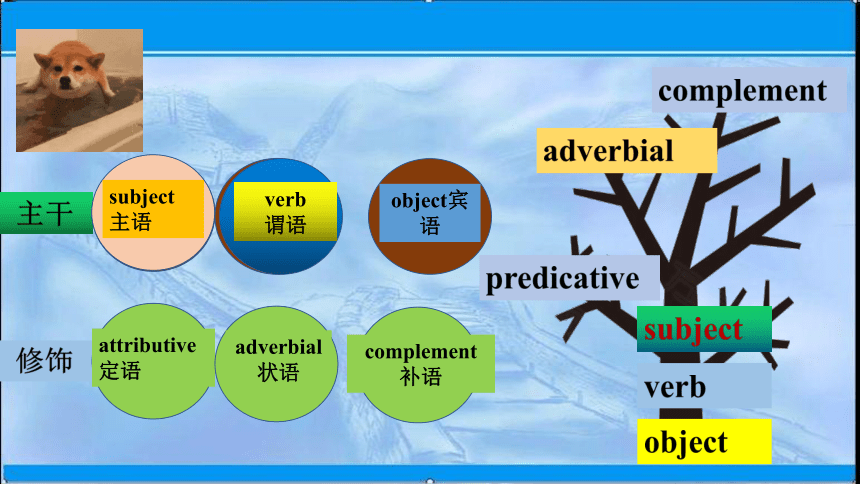
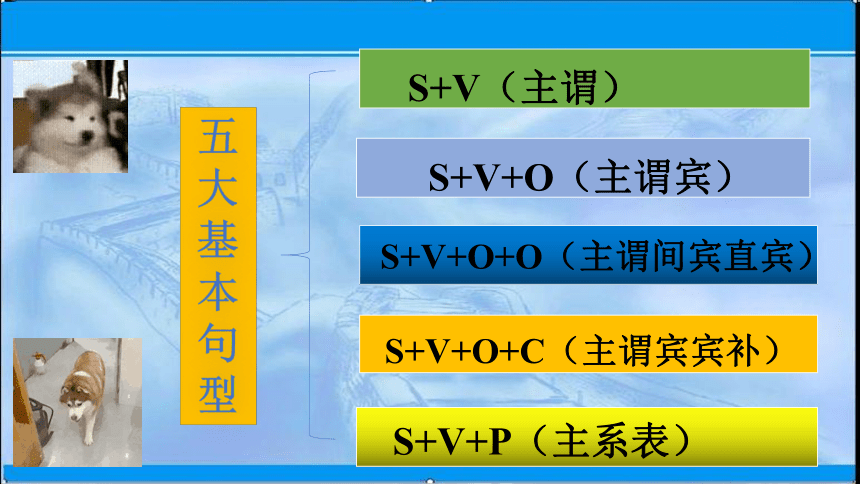
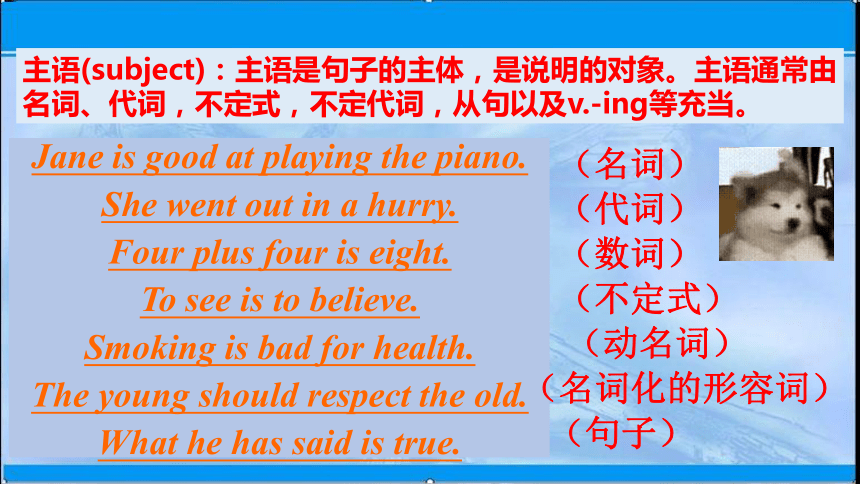
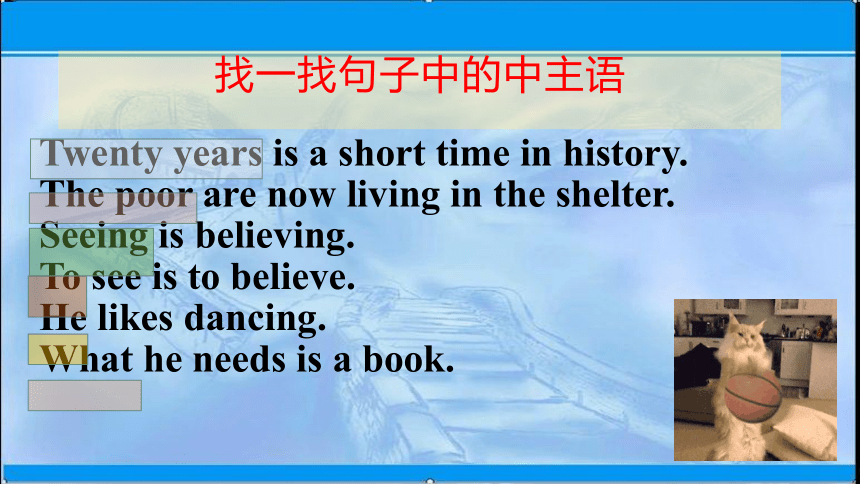
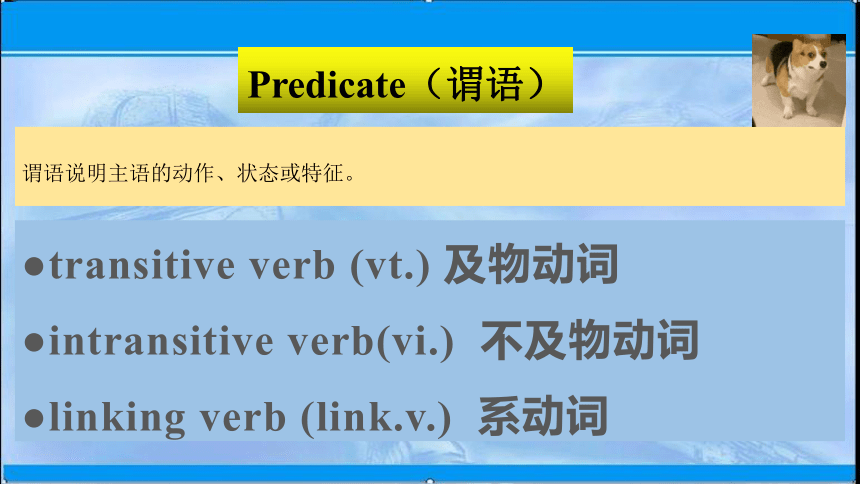
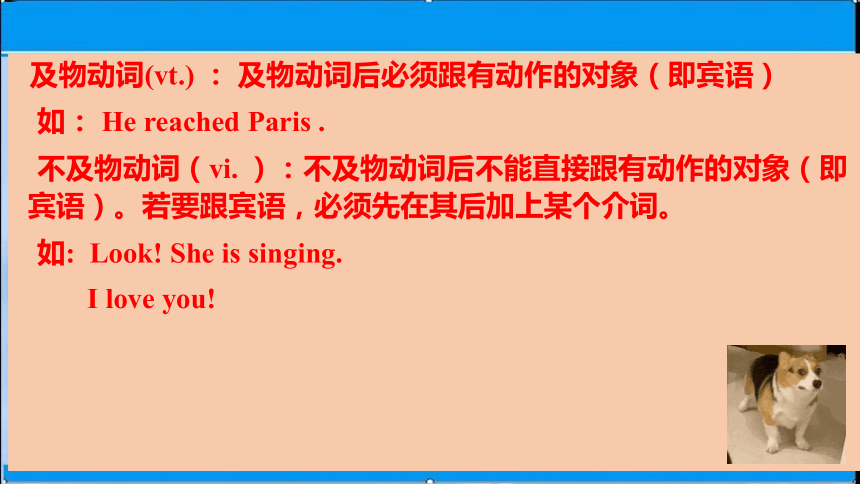
文档简介
(共25张PPT)
Welcome
Unit
grammar
1.Learn
to
know
the
basic
sentence
structures
of
English.
2.Learn
to
analyze
the
structure
of
the
sentences
from
the
text.
Learning
objectives
S
表示
“主语(subject)”
V表示
“动词(verb)”
P表示
“表语(predicative)”
O表示
“宾语(object)”
C表示
“补语(complement)”
IO表示
“间接宾语(indirect
object)”
DO表示
“直接宾语(direct
object)”
subject
主语
verb
谓语
object宾语
subject
主语
verb
谓语
S+V(主谓)
S+V+O(主谓宾)
S+V+O+O(主谓间宾直宾)
S+V+O+C(主谓宾宾补)
五大基本句型
S+V+P(主系表)
Jane
is
good
at
playing
the
piano.
She
went
out
in
a
hurry.
Four
plus
four
is
eight.
To
see
is
to
believe.
Smoking
is
bad
for
health.
The
young
should
respect
the
old.
What
he
has
said
is
true.
(名词)
(代词)
(数词)
(不定式)
(动名词)
(名词化的形容词)
(句子)
主语(subject):主语是句子的主体,是说明的对象。主语通常由名词、代词,不定式,不定代词,从句以及v.?ing等充当。
找一找句子中的中主语
????????
Twenty
years
is
a
short
time
in
history.
?
The
poor
are
now
living
in
the
shelter.
Seeing
is
believing.?????
To
see
is
to
believe.
????????
He
likes
dancing.????
What
he
needs
is
a
book.
Predicate(谓语)
谓语说明主语的动作、状态或特征。
transitive
verb
(vt.)
及物动词
intransitive
verb(vi.)
不及物动词
linking
verb
(link.v.)
系动词
及物动词(vt.)
:
及物动词后必须跟有动作的对象(即宾语)
如:
He
reached
Paris
.
不及物动词(vi.
):不及物动词后不能直接跟有动作的对象(即宾语)。若要跟宾语,必须先在其后加上某个介词。
如:
Look!
She
is
singing.
I
love
you!
Object(宾语)
宾语表示动作的对象,主动语态中宾语是动作的承受者。宾语一般位于及物动词和介词之后。
宾语由名词,代词,不定式,动名词,从句等或者是相当于名词的词或者是短语充当
(句子)
Show
your
book,
please.
She
didn't
know
anything.
They
want
to
know
my
idea.
I
like
staying
with
you.
Did
you
know
what
she
want?
(名词
)
(
代词)
(不定式)
(动名词)
基本句型
一
S(subject)
+V(verb)(主+谓)
特点:句子的谓语动词都能表达完整的意思。
这类动词叫做不及物动词,后面可以跟副词、介词短语、状语从句等。即:后面不可以直接跟宾语,但可以加介词再加宾语
S
V
(不及物动词)
1.
Time
2.
The
moon
3.
We
all
4.
They
5.
He
6.
He
7.
They
flies.
rose.
eat,
and
drink.
talked
for
half
an
hour.
walked
yesterday.
is
playing.
listens
to
classical
music..
不及物动词后面不可直接加宾语。如需要加宾语,需要添加介词
基本句型
二
S
+V
+O(主+谓+宾)
特点:宾语表示动作的对象或行为的承受者,一般位于及物动词(短语)和介词后面,一般由名词、代词、数词、动词不定式(短语)、动名词(短语)等充当。
S
V(实义动词)
O(宾语)
1.
Who
2.
She
3.
He
4.
He
5.
They
6.
Danny
7.
I
8.
He
knows
laughs
at
understands
made
ate
likes
want
said
the
answer?
her.
English.
cakes.
some
apples.
donuts.
to
have
a
cup
of
tea.
"Good
morning."
基本句型
三
S
+V
+P(主+系+表)
此句型的句子有一个共同的特点:句子的系动词都不能表达一个完整的意思,必须加上一个表明主语身份或状
态的表语,才能表达完整的意思。表语多为形容词,也可以是名词、介词短语、动名词等。
常见的系动词
1.be
本身没有什么意义,只起连系主语和表语的作用,后可接动词外的任何词;
2.感官动词类
look,
feel,
smell,
taste,
sound等
3.表示变化:get,
grow,
become,
turn,
go等
4.表示状态延续:stay,
keep,
remain,
stand等。
S
V
P(表语)
1.
This
2.
The
dinner
3.
He
4.
Everything
5.
He
6.
The
book
7.
The
weather
8.
His
face
is
smells(闻)
fell
looks
is
is
became
turned
an
English
dictionary.
good.
happy.
different.
tall
and
strong.
interesting.
warmer.
red.
基本句型
四
S
+V
+IO
+DO(主+谓+间宾+直宾)
此句型的句子有一个共同特点:谓语动词后面必须有两个宾语才能表达完整的意思。这两个宾语一个是动作的直接承受者(物),另一个是动作的间接承受者(人)。
S
V(及物)
o(多指人)
O(多指物)
1.
She
2.
She
3.
He
4.
He
5.
I
6.
I
7.
I
8.
He
passed
cooked
brought
bought
showed
gave
told
showed
him
her
husband
you
her
him
him
me
a
new
dress.
a
delicious
meal.
a
dictionary.
nothing.
my
pictures.
a
hand.
how
to
run
the
machine.
that
the
bus
was
late.
常跟双宾语的动词有:(需借助to的)bring,
give,
lend,
pass,
pay,
promise,
return,
send,
show,
teach,
tell,
write,
ask等;
(需借助for
的)
buy,
call,
cook,
choose,
draw,
find,
get,
make,
order,
sing,
save,
等。
基本句型
五
S
+V
+O
+C(主+谓+宾+宾补)
此句型的句子的共同特点是:动词虽然是及物动词,但是只跟一个宾语还不能表达完整的意思,必须加上一个补充成分来补足宾语,才能使意思完整。
S
V(及物)
O(宾语)
C(宾补)
1.
We
2.
They
3.
They
4.
They
5.
What
6.
We
7.
He
8.
I
keep
painted
call
found
makes
saw
asked
saw
the
table
the
door
supper
the
house
him
him
me
them
clean.
green.
dinner.
dirty.
sad?
out.
to
come
back
soon.
getting
on
the
bus.
【语境应用】判断句子结构类型。
1)
Everybody
smiled.
2)
The
car
caught
fire.
3)
Did
the
milk
turn
sour?
4)
He
bought
his
wife
a
dress.
5)
Roy
found
his
new
job
rather
boring.
6)
Your
brother
got
up
at
10
o’clock.
7)
Are
there
any
gardens
in
the
town?
SVOC
SVA
there
be
SV
SVO
SP
SVIODO
THANK
YOU!
Welcome
Unit
grammar
1.Learn
to
know
the
basic
sentence
structures
of
English.
2.Learn
to
analyze
the
structure
of
the
sentences
from
the
text.
Learning
objectives
S
表示
“主语(subject)”
V表示
“动词(verb)”
P表示
“表语(predicative)”
O表示
“宾语(object)”
C表示
“补语(complement)”
IO表示
“间接宾语(indirect
object)”
DO表示
“直接宾语(direct
object)”
subject
主语
verb
谓语
object宾语
subject
主语
verb
谓语
S+V(主谓)
S+V+O(主谓宾)
S+V+O+O(主谓间宾直宾)
S+V+O+C(主谓宾宾补)
五大基本句型
S+V+P(主系表)
Jane
is
good
at
playing
the
piano.
She
went
out
in
a
hurry.
Four
plus
four
is
eight.
To
see
is
to
believe.
Smoking
is
bad
for
health.
The
young
should
respect
the
old.
What
he
has
said
is
true.
(名词)
(代词)
(数词)
(不定式)
(动名词)
(名词化的形容词)
(句子)
主语(subject):主语是句子的主体,是说明的对象。主语通常由名词、代词,不定式,不定代词,从句以及v.?ing等充当。
找一找句子中的中主语
????????
Twenty
years
is
a
short
time
in
history.
?
The
poor
are
now
living
in
the
shelter.
Seeing
is
believing.?????
To
see
is
to
believe.
????????
He
likes
dancing.????
What
he
needs
is
a
book.
Predicate(谓语)
谓语说明主语的动作、状态或特征。
transitive
verb
(vt.)
及物动词
intransitive
verb(vi.)
不及物动词
linking
verb
(link.v.)
系动词
及物动词(vt.)
:
及物动词后必须跟有动作的对象(即宾语)
如:
He
reached
Paris
.
不及物动词(vi.
):不及物动词后不能直接跟有动作的对象(即宾语)。若要跟宾语,必须先在其后加上某个介词。
如:
Look!
She
is
singing.
I
love
you!
Object(宾语)
宾语表示动作的对象,主动语态中宾语是动作的承受者。宾语一般位于及物动词和介词之后。
宾语由名词,代词,不定式,动名词,从句等或者是相当于名词的词或者是短语充当
(句子)
Show
your
book,
please.
She
didn't
know
anything.
They
want
to
know
my
idea.
I
like
staying
with
you.
Did
you
know
what
she
want?
(名词
)
(
代词)
(不定式)
(动名词)
基本句型
一
S(subject)
+V(verb)(主+谓)
特点:句子的谓语动词都能表达完整的意思。
这类动词叫做不及物动词,后面可以跟副词、介词短语、状语从句等。即:后面不可以直接跟宾语,但可以加介词再加宾语
S
V
(不及物动词)
1.
Time
2.
The
moon
3.
We
all
4.
They
5.
He
6.
He
7.
They
flies.
rose.
eat,
and
drink.
talked
for
half
an
hour.
walked
yesterday.
is
playing.
listens
to
classical
music..
不及物动词后面不可直接加宾语。如需要加宾语,需要添加介词
基本句型
二
S
+V
+O(主+谓+宾)
特点:宾语表示动作的对象或行为的承受者,一般位于及物动词(短语)和介词后面,一般由名词、代词、数词、动词不定式(短语)、动名词(短语)等充当。
S
V(实义动词)
O(宾语)
1.
Who
2.
She
3.
He
4.
He
5.
They
6.
Danny
7.
I
8.
He
knows
laughs
at
understands
made
ate
likes
want
said
the
answer?
her.
English.
cakes.
some
apples.
donuts.
to
have
a
cup
of
tea.
"Good
morning."
基本句型
三
S
+V
+P(主+系+表)
此句型的句子有一个共同的特点:句子的系动词都不能表达一个完整的意思,必须加上一个表明主语身份或状
态的表语,才能表达完整的意思。表语多为形容词,也可以是名词、介词短语、动名词等。
常见的系动词
1.be
本身没有什么意义,只起连系主语和表语的作用,后可接动词外的任何词;
2.感官动词类
look,
feel,
smell,
taste,
sound等
3.表示变化:get,
grow,
become,
turn,
go等
4.表示状态延续:stay,
keep,
remain,
stand等。
S
V
P(表语)
1.
This
2.
The
dinner
3.
He
4.
Everything
5.
He
6.
The
book
7.
The
weather
8.
His
face
is
smells(闻)
fell
looks
is
is
became
turned
an
English
dictionary.
good.
happy.
different.
tall
and
strong.
interesting.
warmer.
red.
基本句型
四
S
+V
+IO
+DO(主+谓+间宾+直宾)
此句型的句子有一个共同特点:谓语动词后面必须有两个宾语才能表达完整的意思。这两个宾语一个是动作的直接承受者(物),另一个是动作的间接承受者(人)。
S
V(及物)
o(多指人)
O(多指物)
1.
She
2.
She
3.
He
4.
He
5.
I
6.
I
7.
I
8.
He
passed
cooked
brought
bought
showed
gave
told
showed
him
her
husband
you
her
him
him
me
a
new
dress.
a
delicious
meal.
a
dictionary.
nothing.
my
pictures.
a
hand.
how
to
run
the
machine.
that
the
bus
was
late.
常跟双宾语的动词有:(需借助to的)bring,
give,
lend,
pass,
pay,
promise,
return,
send,
show,
teach,
tell,
write,
ask等;
(需借助for
的)
buy,
call,
cook,
choose,
draw,
find,
get,
make,
order,
sing,
save,
等。
基本句型
五
S
+V
+O
+C(主+谓+宾+宾补)
此句型的句子的共同特点是:动词虽然是及物动词,但是只跟一个宾语还不能表达完整的意思,必须加上一个补充成分来补足宾语,才能使意思完整。
S
V(及物)
O(宾语)
C(宾补)
1.
We
2.
They
3.
They
4.
They
5.
What
6.
We
7.
He
8.
I
keep
painted
call
found
makes
saw
asked
saw
the
table
the
door
supper
the
house
him
him
me
them
clean.
green.
dinner.
dirty.
sad?
out.
to
come
back
soon.
getting
on
the
bus.
【语境应用】判断句子结构类型。
1)
Everybody
smiled.
2)
The
car
caught
fire.
3)
Did
the
milk
turn
sour?
4)
He
bought
his
wife
a
dress.
5)
Roy
found
his
new
job
rather
boring.
6)
Your
brother
got
up
at
10
o’clock.
7)
Are
there
any
gardens
in
the
town?
SVOC
SVA
there
be
SV
SVO
SP
SVIODO
THANK
YOU!
